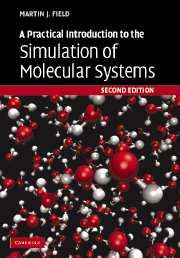Book contents
- Frontmatter
- Contents
- Preface to the first edition
- Preface to the second edition
- 1 Preliminaries
- 2 Chemical models and representations
- 3 Coordinates and coordinate manipulations
- 4 Quantum chemical models
- 5 Molecular mechanics
- 6 Hybrid potentials
- 7 Finding stationary points and reaction paths on potential energy surfaces
- 8 Normal mode analysis
- 9 Molecular dynamics simulations I
- 10 More on non-bonding interactions
- 11 Molecular dynamics simulations II
- 12 Monte Carlo simulations
- Appendix 1 The pDynamo library
- Appendix 2 Mathematical appendix
- Appendix 3 Solvent boxes and solvated molecules
- Bibliography
- Author index
- Subject index
6 - Hybrid potentials
Published online by Cambridge University Press: 03 December 2009
- Frontmatter
- Contents
- Preface to the first edition
- Preface to the second edition
- 1 Preliminaries
- 2 Chemical models and representations
- 3 Coordinates and coordinate manipulations
- 4 Quantum chemical models
- 5 Molecular mechanics
- 6 Hybrid potentials
- 7 Finding stationary points and reaction paths on potential energy surfaces
- 8 Normal mode analysis
- 9 Molecular dynamics simulations I
- 10 More on non-bonding interactions
- 11 Molecular dynamics simulations II
- 12 Monte Carlo simulations
- Appendix 1 The pDynamo library
- Appendix 2 Mathematical appendix
- Appendix 3 Solvent boxes and solvated molecules
- Bibliography
- Author index
- Subject index
Summary
Introduction
The last two chapters considered two distinct classes of methods for calculating the potential energy of a system. Chapter 4 discussed QC techniques. These are, in principle, the most ‘exact’ methods but they are expensive and so are limited to studying systems with relatively small numbers of atoms. MM approaches were introduced in Chapter 5. These represent the interactions between particles in a simpler way than do QC methods and so are more rapid and, hence, applicable to much larger systems. They have the disadvantage, though, of being unsuitable for treating some processes, notably chemical reactions. Hybrid potentials, which are described in this chapter, seek to overcome some of the limitations of QC and MM methods by putting them together.
Combining QC and MM potentials
Although a hybrid potential is, in principle, any method that employs different potentials to treat a system, either spatially or temporally, the potentials we focus upon in this chapter use a combination of QC and MM techniques. These methods are also known as QC/MM or QM/MM potentials. The first potential of this type was developed in the 1970s by A. Warshel and M. Levitt who were studying the mechanism of the chemical reaction catalyzed by the enyzme lysozyme. Enzymes are proteins that can greatly accelerate the rate of certain chemical reactions. How they achieve this is still a matter of active research but the reaction itself occurs when the substrate species are bound close together in a specific part of the enzyme called the active site.
Information
- Type
- Chapter
- Information
- A Practical Introduction to the Simulation of Molecular Systems , pp. 110 - 121Publisher: Cambridge University PressPrint publication year: 2007
